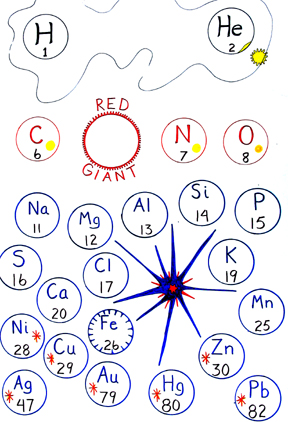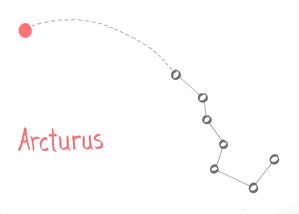
|
We Are Made of Stardust Toward a New Periodic Table of Elements Compiled by Connie Barlow April 2003 |
"Thank you for spending so much time with us. You were so energetic. It was unbelievable that we are 13 billion years old! and that we are made out of stardust. It makes me feel like a Goddess. I don't like it. I love it." — Love, Eileen, a student at a Montessori school in Minneapolis. "Thank you for telling us that we all are 13 billion years old. When you said I am made of star dust, I was very happy because I like space and I want to be part of it. I feel like a alien. Please please please come again." — Love, Liza, a Montessori student
"Stars mimic living systems. They are born, live to maturity at metabolic rates determined by their masses, and die, spewing forth the matter by which their stellar offspring can take form. Throughout, they convert the light atoms of their birth into the heavier ones dispersed at death. The chemicals that constitute our beings were manufactured in the bowels of stars that today exist only as memories." — George A. Seielstad, "Cosmic Ecology," 1983. When the Siberian chemist, Mendeleev, conceived The Periodic Table of Elements around 1870, he catalogued atoms according to the number of protons in each nucleus and grouped the elements by chemical properties. This was a huge achievement. It has been the basis for the science of chemistry ever since. Today, however, we have an opportunity to construct another version of the Periodic Table of Elements — one that can highlight where each element arose.
PERHAPS THE DEEPEST SPIRITUAL CONNECTION to the vast Universe that science has given us is an awareness that ancestral stars are part of our genealogy. We can now know and feel our connection to the heavens, for stars are among our ancestors. Every atom in our bodies, other than hydrogen, was forged in the fiery belly of a star who lived and died before our own star, the Sun, was born.
LISTEN to Neil deGrasse Tyson
speak on the spiritual significance of the science of stardust.

This awareness of atomic origins was made possible by scientific discoveries beginning in the 1920s and culminating in the late 1950s and 60s. You can access online Synthesis of the Elements in Stars, which is the classic, 1957 technical paper. Also, a contemporary technical presentation: The Evolution of High-Mass Stars. Wikipedia recounts the history of this understanding in the topic Stellar Nucleosynthesis. Each year new discoveries flesh out even more details, enhancing our appreciation of stellar ancestors and the cosmic recycling of atoms.
CONTENTS:
1. The Highlights
2. A New Periodic Table of Elements (by mode of origin)
3. Elemental Origins (of the most familiar chemical elements)
4. Stellar Longevity v. Creativity + CHART
5. More Details on the Sequence of Stellar Nucleosynthesis
Note: Stellar nucleosynthesis is a complex process to understand. The author will happily correct and update this file when errors are brought to her attention.
Learning The Story of Stardust ("Stellar Nucleosynthesis") can elicit awe and wonder in a number of ways. Before moving into more detailed explanations of astronomy and chemistry from which the story is drawn, here in brief are the points that elicit the most "Wow" responses:



Red Giant stars Antaries in Scorpio, Betelgeuse in Orion, and Arcturus "arcing" from the Big Dipper actually look reddish to the naked eye.
ABOVE: Click the image above for the wikipedia site where you can learn about it. The rest of this document is available only in PDF format. You can easily download it by clicking HERE.
If you plan to offer a stardust workshop or conduct a stardust ritual, you might wish to distribute to participants a 1-page flier, which can be downloaded HERE.
A powerful comparative illustration of a neuron in a brain and astrophysicist's computer simulation of how the galaxies formed: http://1.bp.blogspot.com/_CD0JETuihEE/SRitMQdRsDI/AAAAAAAAD3M/Nw5TuVeywQQ/s1600-h/neuron-galaxy.jpg
A companion to the full PDF document is a scientifically rigorous but poetic rendering of the forms and uses of each of the most familiar elements, especially those crucial for life. This document can be accessed directly on this website. Simply scroll down to the element-by-element description in our "Feast of Elements" document.
Home | About The Great Story | About Us | Traveling Ministry and Events
What Others Say | Programs and Presentations | Metareligious Essays | Writings/Rituals
Great Story Beads | Online Bookstore | Parables | Sacred Sites
Highlights of Our Travels | Favorite Links & Resources | Join Us! | WHAT's NEW?
